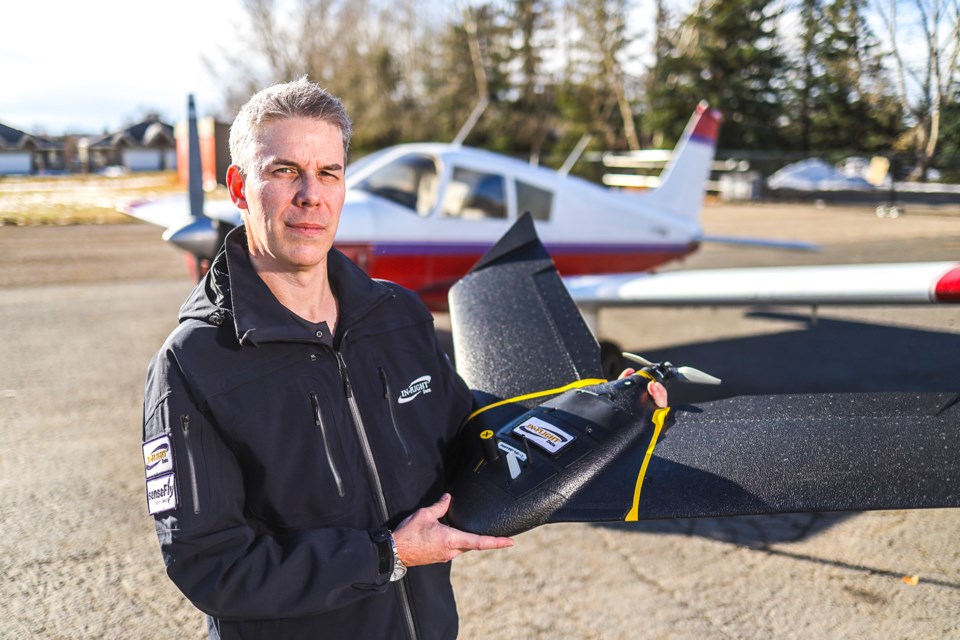An Alberta drone expert is bringing new technology to bear against wildfires.
After leading the charge in Canada for Beyond Visual Line of Sight (BVLOS) operations, Chris Healy's IN-FLIGHT Data Group has been using drones to assist in wildfire management since 2020.
New authorizations from Transport Canada have given him a force multiplier: flying synchronous drone swarms.
“We’re really excited about this. This is a new advancement in terms of using technology to fight wildfires,” Healy said. “We’ve been able to fly drones over wildfires since 2020, and this is the next iteration and next step.
“This year we’ve been doing 200-250 kilometres of flight a night, and now with simultaneous drone operations, we can take that up to about 1,000 kilometres per night.
“That’s for doing fire analysis and hot spot marking and other fire-related data collection activities."
Covering that ground lets Healy arm firefighters with better, up-to-date intelligence.
Currently working with multiple provincial firefighting authorities in Western Canada, the operator is turning around the data in time for the next shift of firefighters to head out the following morning.
The drones — known officially as Remotely Piloted Aircraft Systems — most commonly seen by the public are consumer-grade quadcopters. Drones used by IN-FLIGHT, which operates out of the Okotoks and Springbank airports, are an entirely different animal.
At one time, Healy’s crew can operate up to five eBee X fixed-wing drones from a single control station, the maximum currently allowed outside of special operations such as drone light shows.
Each of the drones is equipped with highly sensitive imaging payloads.
“The aircraft carry a very accurate and calibrated infrared sensor produced by FLIR,” Healy said. “That camera collects thousands and thousands of pictures every night, flying in a swarm we would take more than 10,000 photos in a night."
The drone operators then feed that information into proprietary artificial intelligence that geolocates the hot spots.
“We take that information and produce a data deliverable that the fire commander issues to their boots on the ground, and that takes them directly to where that hot spot is located on their GPS device,” Healy said, adding he’s heard first-hand accounts how accurate his intel has been.
“I was talking to a member of the crew working with some Australians, and he said the coordinates we gave him took him right to the spot where his boots started to melt.”
As the wildfire season wears on and resources become strained, Healy said he is satisfied his intelligence is being used to great effect.
“That’s a very important thing, because what we were able to do was introduce cost reductions to working with the fire by being very efficient with the crews' time and where to specifically to go to put out hot spots,” he said.
Generally, Transport Canada prohibits members of the public flying drones over forest fires and emergency scenes through the Canadian Aviation Regulations (CARs).
Foothills Fire Department even had to halt firefighting at a 2022 DeWinton-area house fire when a rogue consumer drone flew over the scene.
Emergency personnel, including Okotoks Fire and Rescue, however, have begun adopting the flying eyes in an official capacity to give firefighters an overview to better direct their efforts.
The sort of operation IN-FLIGHT is performing falls well outside of Transport Canada’s Basic or Advanced Operations Pilot Certificates, but as an expert in BVLOS operations, Healy has obtained the go-ahead with a Special Flight Operations Certificate (SFOC) from Transport Canada, with specific conditions.
“When I’m operating my aircraft, it has to be done under provincial authority, and under the fire control authority, as per the Canadian Aviation Regulations,” Healy said, adding spontaneous volunteers, regardless of their licence, could not lend a hand.
“That’s a really important distinction. You have to have the SFOC, plus you have to have the permission from the fire control authority of the province.”
Beyond that, he said, provincial bodies also have rigorous qualifications operators have to meet in order to be contracted for wildfire work.
Transport Canada just recently announced proposed regulations for low-risk BVLOS operations, which Healy said are going to further shift the paradigm of what drone operators can do.
“It’s going to make it a lot different for people to fly beyond line of sight when those new regulations come in, which will include new training, a new licence, and a higher bar of standard for people, the aircraft, the procedures, for people to fly BVLOS in the future, which will also include for wildfire work,” Healy said.
“It’s cool and it is a game changer, whether it’s a structural fire or wildfire, being able to get that aerial eye in the sky does introduce a whole new way of looking at the event and being able to manage it with a greater depth of information.”



